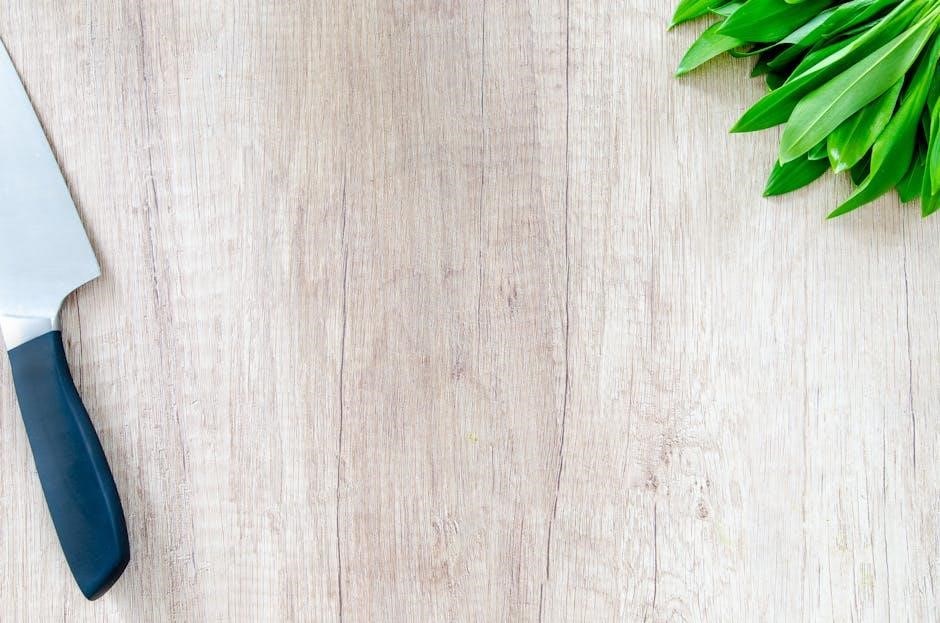Knives are essential tools offering versatility in daily tasks, culinary arts, and outdoor activities. This guide explores their history, design, and maintenance, helping you choose the right blade for every need.
1.1 Importance of Knives in Everyday Life
Knives are indispensable tools in daily life, serving both practical and essential purposes. From preparing meals to outdoor activities, their versatility makes them a cornerstone in kitchens and workshops. Whether slicing ingredients, cutting rope, or opening packages, a reliable knife enhances efficiency and safety. Their multi-functional design caters to various needs, making them a must-have for professionals and home users alike. The right blade can transform tasks, ensuring precision and ease. Understanding their importance helps in selecting the best knife for specific roles, optimizing performance in everyday scenarios. This guide highlights their significance, helping users appreciate their value across different contexts and activities.
1.2 Brief History of Knives
Knives have been integral to human progress since prehistoric times, evolving from simple stone tools to sophisticated designs. Early humans used flint and bone for cutting, while later advancements in metallurgy introduced bronze, iron, and steel blades. The development of knives reflected technological and cultural advancements, with ancient civilizations crafting specialized blades for both utility and ceremonial purposes. The modern era saw the rise of iconic designs like the Swiss Army Knife, emphasizing multi-functionality. This historical journey highlights how knives have adapted to meet human needs, blending practicality with innovation. Understanding their origins provides insight into their enduring relevance across cultures and time.
Types of Knives
Knives come in various types, each designed for specific tasks. Chef’s knives are ideal for cooking, pocket knives for portability, and fixed-blade knives for durability. Swiss Army knives offer multi-tool functionality, making them versatile for different needs. Choosing the right type ensures efficiency and safety in any situation.
2.1 Chef’s Knives
Chef’s knives are versatile tools designed for precision and efficiency in the kitchen. They feature a broad, curved blade that allows for smooth chopping, slicing, and mincing. Made from high-quality materials like stainless steel or carbon steel, these knives are durable and maintain a sharp edge. The ergonomic handle ensures comfort during prolonged use, making them ideal for both professional chefs and home cooks. Whether preparing intricate dishes or everyday meals, a chef’s knife is an indispensable asset. Its balance and sharpness enable precise cuts, while the curved edge facilitates rocking motions for efficient food preparation. Investing in a good chef’s knife is a cornerstone of building a functional knife collection.
2.2 Pocket Knives
Pocket knives are compact, portable tools designed for everyday carry and versatility. They often feature folding blades and multi-tool functionality, making them ideal for tasks like cutting, slicing, and even opening packages. Popular models, such as the Swiss Army Knife, offer additional features like screwdrivers, bottle openers, and can openers. These knives are perfect for outdoor enthusiasts, professionals, and anyone needing a reliable tool on the go. Their compact size and durability ensure they remain a practical choice for various situations. Whether for camping, DIY projects, or emergency use, pocket knives provide convenience and reliability, making them a timeless accessory for both utility and convenience.
2.3 Fixed Blade Knives
Fixed blade knives are durable and robust tools, featuring a blade that remains permanently exposed. They are often preferred for heavy-duty tasks, outdoor activities, and professional use due to their strength and reliability. Unlike folding knives, fixed blades lack moving parts, making them less prone to mechanical failure. Popular for camping, hunting, and tactical purposes, these knives are designed for precision and endurance. Their full tang construction enhances stability, while ergonomic handles ensure comfortable grip and control. Fixed blade knives are ideal for slicing, chopping, and carving, making them indispensable for both enthusiasts and professionals seeking a dependable cutting instrument for challenging environments and demanding applications.

Knife Anatomy
A knife’s anatomy includes the blade, handle, and tang, each serving crucial functions. The blade’s shape and edge determine its use, while the handle and tang ensure durability and control.
3.1 Blade Types and Shapes
Blades vary in shape and design, catering to specific tasks. Straight-edge blades are ideal for precision cutting, while serrated edges excel at slicing through tough or fibrous materials. Curved blades, like those in cleavers, are perfect for chopping, and tapered blades offer versatility for both slicing and chopping. The angle of the blade, typically between 15 to 30 degrees, affects sharpness and durability. Thinner blades are suited for delicate tasks, while thicker ones withstand heavy-duty use. Materials like stainless steel and carbon steel also influence performance, with stainless steel offering corrosion resistance and carbon steel providing superior sharpness. Understanding these variations helps in selecting the right blade for any application.
3.2 Handle Materials and Designs
Knife handles are crafted from diverse materials, each offering unique benefits. Wood handles provide a classic, ergonomic grip, while metal handles, such as those made from stainless steel or titanium, are durable and low-maintenance. Plastic and composite materials, like G10, are lightweight and resistant to moisture. Handles may also feature textured patterns or contoured designs for improved grip and control. Some knives incorporate rivets or bolts for added strength, while others use friction or locking mechanisms in folding designs. The choice of material and design depends on the intended use, ensuring comfort, functionality, and longevity for both professionals and enthusiasts.
3.3 Tang and Guard
The tang is the portion of the blade that extends into the handle, providing structural integrity and balance. A full tang, where the metal runs the entire length of the handle, is prized for strength and durability. Partial tangs are lighter but less robust. The guard, typically a metal piece at the blade’s base, protects the hand from slipping onto the edge. Guards can be integral to the blade or added separately. Materials like stainless steel or titanium are common for their durability. The design and material choices for tang and guard significantly impact the knife’s performance, safety, and overall feel, catering to various user preferences and applications.

Knife Maintenance
Proper knife maintenance involves regular sharpening, cleaning, and storage to ensure longevity and functionality. Sharpening techniques and cleaning methods preserve the blade’s edge and prevent corrosion, while storing knives in dry places or protective cases avoids damage and maintains sharpness for optimal performance and safety.
4.1 Sharpening Techniques
Sharpening is crucial for maintaining a knife’s effectiveness. Common techniques include using whetstones, diamond stones, or electric sharpeners. A 15-20 degree angle is typical for most blades, with lighter pressures for finer edges. Consistency is key to achieving a razor-sharp edge. For beginners, guided sharpeners help maintain the correct angle, while experienced users may prefer freehand honing. Regular honing extends the knife’s life and ensures optimal performance. Proper sharpening also enhances safety by preventing dull blades, which can slip and cause accidents. Using the right tools and techniques ensures your knife remains in peak condition for years of reliable service.
4.2 Cleaning and Storing Knives

Proper cleaning and storage are vital for maintaining knife quality and safety. Clean knives immediately after use, especially after cutting acidic foods, to prevent corrosion. Dry thoroughly to avoid rust. Store knives in a dry place, such as a knife block, magnetic strip, or protective case. Avoid storing them in humid environments or dishwashers. For fixed-blade knives, always pass the handle first when handing to someone. Regular cleaning and proper storage extend the lifespan of your knives and ensure they remain sharp and functional. This care also prevents accidents and maintains hygiene, keeping your knives in optimal condition for years of reliable use.

Knife Safety and Etiquette
Always handle knives with care, cutting away from your body. Pass knives by the handle and store them safely. Proper etiquette ensures safety and respect for the tool.
5.1 Proper Handling and Usage
Proper handling and usage of knives are the foundation of safety and efficiency. Always grip the knife firmly, with a controlled yet comfortable hold, ensuring your fingers are away from the blade. When cutting, maintain a stable cutting board and slice away from your body. Use the correct knife for the task to avoid accidents. Keep your eyes on the blade and the material being cut. When passing a knife, hand it by the handle, ensuring the blade is visible to the recipient. Proper technique prevents injuries and extends the knife’s lifespan. Mindfulness and respect for the tool are key to safe and effective use.
5.2 Safety Guidelines
Safety guidelines are crucial when handling knives to prevent accidents. Always clean the knife before and after use to avoid contamination. Store knives in a dry place, away from children, using a sheath or secure block. Never pass a knife by the blade; hand it by the handle. Avoid using dull knives, as they require more force and increase the risk of injury. Keep fingers curled under when cutting and maintain a stable cutting surface. Regularly inspect knives for damage and sharpen them safely using proper tools. Store sharp blades separately to prevent unintended contact. Supervise children when teaching knife handling, emphasizing caution and respect for the tool.
Knife Legislation and Rights
Knife legislation varies globally, with restrictions on automatic and switchblade knives. Carrying laws differ by region, and some advocate for knife rights to protect cultural and practical utility.
6.1 Legal Considerations
Knife laws vary significantly by country and region, with specific restrictions on blade length, type, and carrying methods. Many jurisdictions prohibit automatic knives, switchblades, and gravity knives. In the U.S., federal law allows interstate transport of knives, but state and local laws differ. For example, some states permit concealed carry of folding knives, while others restrict blade lengths or require knives to be carried openly. Internationally, countries like the UK, Canada, and Australia enforce strict regulations, often banning certain knife types for public safety. Understanding local laws is crucial to avoid legal consequences. Always research and comply with regulations before purchasing or carrying a knife.
